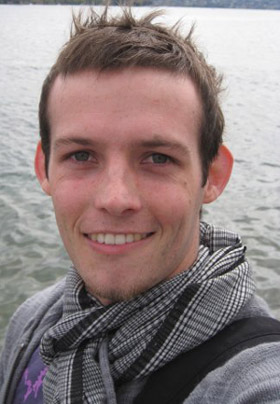 Meet James Drewe, Digital Planner at Starcom Worldwide‘s Brisbane office. Starcom is a media agency that focuses on the strategic implementation of advertising and marketing objectives. James deals with sweet digital projects every day. Jealous?
Meet James Drewe, Digital Planner at Starcom Worldwide‘s Brisbane office. Starcom is a media agency that focuses on the strategic implementation of advertising and marketing objectives. James deals with sweet digital projects every day. Jealous?
James, Starcom seem a lucrative company to break into. How’d you first hear of them, and how’d you talk your way inside?
I had the possibility of taking two subjects’ worth of work experience in my final year of university and I really wanted to take advantage of that opportunity, so I did a lot of research on advertising agencies and weighed them all up based on a few factors which I thought (at the time) were important to what I wanted to get out of my career. I looked at the global size of the company and their clients. Starcom was on the list, along with half a dozen other agencies with offices in Australia.
How did I talk my way in? The old fashioned way – networking. University is about what you know, but the workforce is also about who you know. So I began to network in order to approach the right people in the industry. Timing was also on my side, as Starcom happened to be looking for a new digital person at the time I made contact with them.
Which degree did you study, and, thinking about your career, how effectively did the coursework prepare you for life in the real world?
Originally I wanted to study 3D animation and work at a company like Pixar, but in my first year I discovered advertising and in my second year I switched to the Queensland University of Technology’s Bachelor of Creative Industries. It was an open-ended degree that allowed me to study the bulk of marketing and advertising subjects from a full Business degree, but also continue my passion for arts by taking electives in film, television and website development.
After looking at how many business subjects I could take, I took as many advertising specific courses as possible, everything from consumer behaviour to copywriting, marketing and PR. Some subjects prepare you better than others, but I can’t comment on the current course because it might have changed.
There are very few courses which focus specifically on media. A Business degree and in particular the Marketing/Advertising Major is very broad in its scope because marketing is a very broad field. Marketing covers advertising, public relations, the look and feel of your brand, consumer behaviour, media, research and more, so it is very tough to focus on your particular interest unless you went on to do post-graduate work.
At the end of the day, you can only learn so much at university and most of it will be theory rather than practical. There are a few team-based subjects where you get the opportunity to prepare a marketing/advertising strategy for a company (made up or potentially real) and these are the closest you will get to applying the theory in a real-world context until you actually land on your feet in the industry.
Tell us about your role at Starcom. How has it has changed during your time there?
My role at Starcom is Digital Planner which encompasses research strategy, media planning, campaign implementation and reporting and analysis. This means that I sit in with our client teams at the time of briefing and help develop their campaign strategies, specifically how those campaigns will play out in the digital space (be that online, digital video, social, mobile or other forms of ‘digital’). I also plan the intricacies of the campaigns, including which sites we will use suggesting ad formats to creative agencies, and implementing (booking) these campaigns. Once a campaign is over I assist with the reporting and analysis of performance and what we can learn for future campaigns.
And, because I know digital (and therefore computers), I’m also substitute IT guy when ours is out of the office!
This role has evolved since I started in 2006. When I was fresh to the agency my primary role was to look after reporting and material management (making sure the correct ads appear in the correct places). The role has definitely grown and my responsibilities are now far greater.
In this Mark Pollard article, he and his merry band of marketing/advertising commentators joyously bash the words and phrases with which you deal each day. Is your blood boiling, or do you agree that the industry tends to disappear up its own arse on occasion?
As you can tell by the number of comments on Mark’s article (45 at last count), this is a sentiment shared by a quite a few people within the ‘digital’ community – I’ve even thrown my two-cents into that post as well.
Marketing as a whole is full of jargon and catchphrases, it’s not just the digital fraternity. However, it seems to me that along with the rise of online and digital marketing, the number of buzzwords has proliferated – you can’t just use generic terms anymore, you have to put your own spin on it.
My blood certainly isn’t boiling after reading the article, it’s been a great opportunity for some of us to have a laugh at ourselves, because at the end of the day we’ve all been guilty of using at least some of ‘those’ words – I know I am.
What are your thoughts on the recent commercialisation of social media – wherein many companies are realising that people are talking about them online, and that they’d best monitor those conversations – and do you think this concept is solid, or a mere phase?
Social media still has a ‘flavour of the month’ feel about it to me but I don’t mean that in a bad way. It just seems that a lot of companies see social media as something they have to jump into because everyone else is. Unfortunately, very few people know how to do it properly and actually turn it into something which can drive measurable business results.
Social media has been around a long time, digital has just made it easier for groups to congregate and get their voice heard. I’d include word-of-mouth marketing, public bulletin boards and to a certain extent free newsletters in the social media category because these are all about people voicing their own opinions. However these three examples are much easier for mass audiences to ignore due to the limited reach these mediums have.
The internet made it a lot easier for groups of like-minded people (say, bitter Walmart employees) to get together and share their passion. When the issue of physical distance is removed from the equation, you no longer have just a small, local community – instead you have a national, or even global – group which has a lot more weight behind it.
I think social media is a great way for some companies to extend their customer service and public relations into an environment that their consumers are actively engaged in; however, there is a very fine line between utilising this space correctly and simply jumping in because ‘Twitter is in the press at the moment’. There are some great examples of companies using social media to their benefit, including Dell and Zappos on Twitter, and there’s just as many examples of companies who have created a lot of bad press for themselves, such as RyanAir.
Financial crisis. Big and scary for advertising agencies. Right? Have the last six months been kind to you?
The financial crisis is affecting different companies and agencies in different ways. There is certainly an overwhelming mood of cautiousness at the moment. Many companies, regardless of industry, are doing it tougher this year than they were at the same time last year – some are choosing not to increase their budgets, others are cutting theirs, some are continuing on with business as usual.
Okay, recession. We get it. Tough times for the job market. Near-impossible to get a start in the creative industries if you’re a recent graduate. Fact or fiction?
Near-impossible might be taking it a bit far, but it certainly is a lot tougher to get a job at the moment, and it is the same in many industries. That doesn’t mean that without some determination you can’t land a job though.
Bearing in mind that Craig Wilson at Media Hunter has recently opined on how to avoid the ‘resume run-around’: if you’d just graduated and wanted to get a start in the advertising industry – with no formal experience – what would you do? You mentioned networking earlier, and that Starcom were on your hitlist when you were looking for a job in 2006. Run us through your self-marketing pitch at the time, and advise how you’d approach the same task in 2009.
I quite liked Craig’s article – I hadn’t seen it previously – and the overall tone of the article certainly rings true. Personally, there is one sentence that stands out for me, right at the start: “I encourage starting a relationship before asking for the job,” and this can only be more important in the current environment.
If you are still at university (or out of university, it doesn’t matter) the best way to build a relationship in an industry you have no contact with is to do work experience. Your course co-ordinator can help you out with organising this and will more than likely they have a few contacts in the industry to help get you started. This is how I got my foot in the door.
I worked at a media agency for two full days a week for 13 weeks with no pay. A lot of people won’t like the ‘no pay’ aspect but to be honest, if you enjoy it then it shouldn’t matter. Build up a rapport with your co-workers, ask if you can go into meetings with them with the media, ask to meet clients and, if you are enthusiastic, and get the work done. Then people will take notice.
This is the same route I took – except I also ended up joining my co-workers when they went to the bar every other Friday night, it’s a great way to meet people in the industry! – and while I didn’t get a job with the agency I did work experience for, I was able to make some calls and find a placement. I had an interview the day after I called in, and a job that afternoon. Sure, I still had a formal interview and had to submit a resume, but I was able to avoid a lot of cold calling and rounds of interviews.
In today’s job market, a similar route will still get you in the door, and that is the important part. You might not be able to land a job with the company you do work experience for, but it will allow you to add some real experience to your resume and you will be able to demonstrate a knowledge of the day-to-day tasks and workings of a company that university can’t teach you.
Great advice, James. Finally, Simon Van Wyk of Hothouse Interactive spurred discussion within the advertising community by declaring that interactive web agencies need to stop behaving like digital advertising agencies. Since Starcom seem to be positioned directly between the two – I might be wrong here, please clarify – what’s your take on Van Wyk’s rant?
First off, I’ll try to clarify the different types of agencies that make an appearance in Simon’s article, and then I’ll get back to the question.
HotHouse Interactive is a company that produces websites and content management systems for their clients (purely based on the content of their website). Then we have digital advertising agencies, I would put companies such as Amnesia|Razorfish and Tribal DDB in this category. Starcom is a strategy and media agency, in that we focus on our clients’ messages being in the right place at the right time. We don’t focus on one particular medium over any other, nor do we create any of the ads, since this is usually the role of a creative agency. For me, when digital suits a client’s objectives, that’s when I get involved.
So back to your original question. Not having worked in an interactive agency (such as HotHouse), I can’t really comment on how much these agencies do (or don’t) want to be like digital advertising agencies, but there is obviously a bit of contention in the industry about how these agencies fit in and act within the industry as a whole. There’s also a slight issue (as many commenters have pointed out beneath that article) that Simon’s rant is exactly that, a rant. Like many rants, it gets off topic a little and I feel like he contradicts himself in places too.
I agree with the stance on social media, as I’ve stated above and some of his points in this industry code of practice also hold some weight. Unfortunately there aren’t any facts or case studies to back up the claims he is making. Ashley Ringrose made a great point that the valid points are muddied by some invalid and sweeping statements.
If the purpose of the rant was to start a discussion about where the different agencies fit within the industry – and there is quite a lot of overlap these days – then Simon has done a fantastic job. However I think a few revisions might have given the article a lot more weight.
James – thanks very much for your thoughts, advice and time.
You can get in touch with James via Twitter.



 Play games. Read books. Watch movies. Understand your world, so that when you’ve learned some hands-on, practical skills, you have ideas to make new, exciting forms of games. Generate your own enthusiasm, and your own, new industry. Don’t go and be a little worker; go and make your own world. I think games are just beautiful. Design is powerful. Game design is utterly powerful. You’re playing with culture and philosophy and fun and image and audio; the whole kit and caboodle. Don’t just think about making new forms; think about pushing the boundaries with it.
Play games. Read books. Watch movies. Understand your world, so that when you’ve learned some hands-on, practical skills, you have ideas to make new, exciting forms of games. Generate your own enthusiasm, and your own, new industry. Don’t go and be a little worker; go and make your own world. I think games are just beautiful. Design is powerful. Game design is utterly powerful. You’re playing with culture and philosophy and fun and image and audio; the whole kit and caboodle. Don’t just think about making new forms; think about pushing the boundaries with it. One of the big things we look for when we’re interviewing people is their portfolio. Whether it be as an artist showing your work, or a programmer and having a playable game; that just puts you so far ahead of other people when you’re applying for a job. And even a designer, if you have a little walkthrough video. One of the guys we hired at Krome for Ty the Tasmanian Tiger 2 – Rob Davis, a graduate, who’s now working at Microsoft Games Studios in Seattle – he had a walkthrough of a Ty The Tasmanian Tiger level that just blew everyone else away. He’d thought about it, and made a level up. He couldn’t program, or really do art, but he did a simple little walkthrough video, and explained his thought processes. That was amazing. It gave him such competitive advantage.
One of the big things we look for when we’re interviewing people is their portfolio. Whether it be as an artist showing your work, or a programmer and having a playable game; that just puts you so far ahead of other people when you’re applying for a job. And even a designer, if you have a little walkthrough video. One of the guys we hired at Krome for Ty the Tasmanian Tiger 2 – Rob Davis, a graduate, who’s now working at Microsoft Games Studios in Seattle – he had a walkthrough of a Ty The Tasmanian Tiger level that just blew everyone else away. He’d thought about it, and made a level up. He couldn’t program, or really do art, but he did a simple little walkthrough video, and explained his thought processes. That was amazing. It gave him such competitive advantage.
 Meet James Drewe, Digital Planner at
Meet James Drewe, Digital Planner at